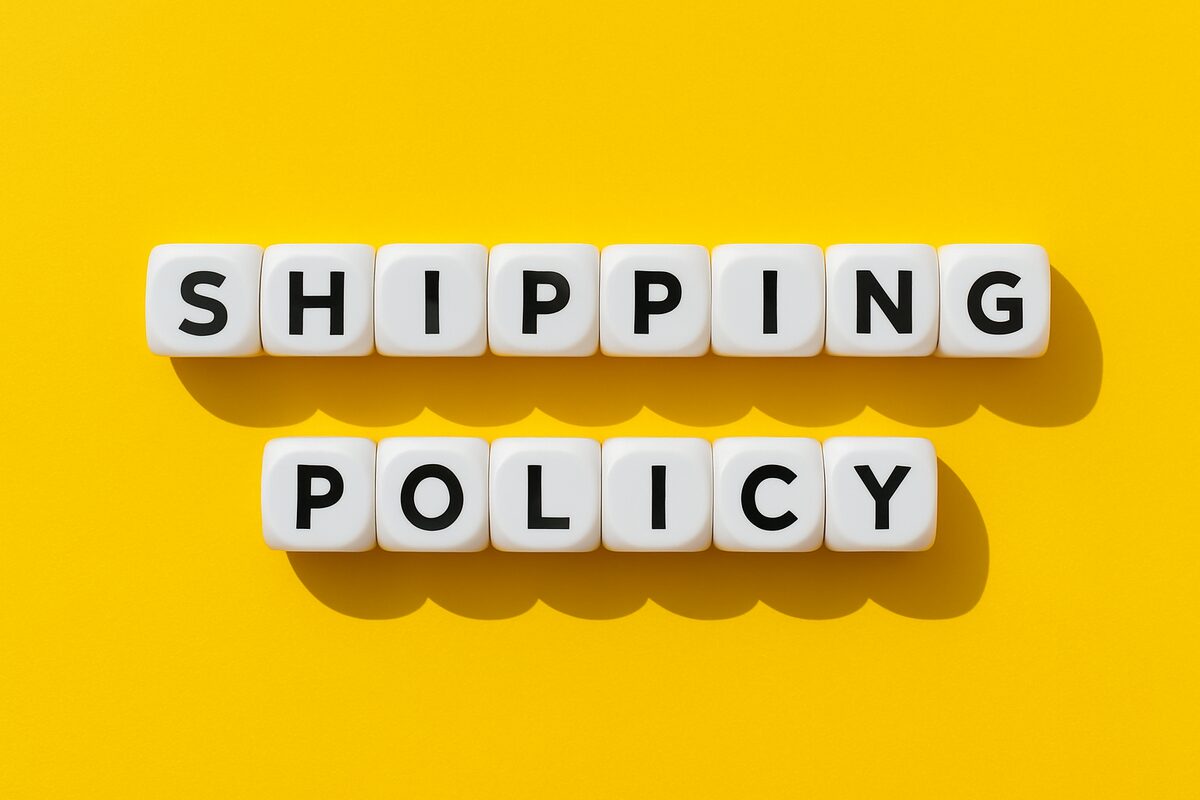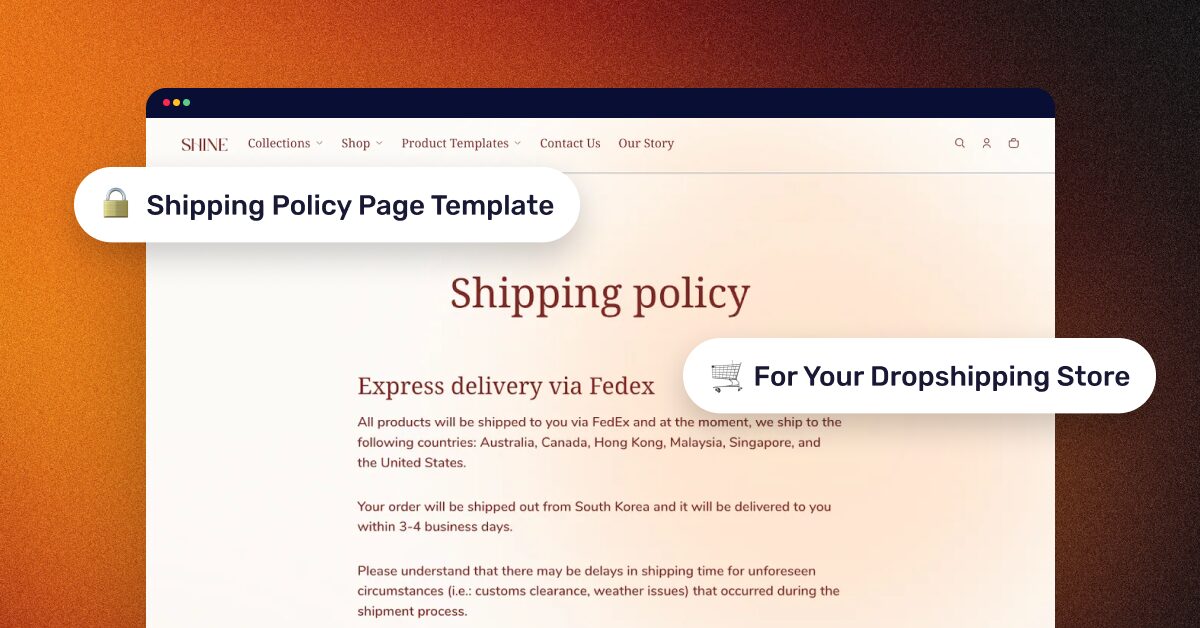Why Every Store Needs a Shipping Policy
One of the most common reasons customers hesitate before hitting “buy” is uncertainty about shipping. How long will it take? What does it cost? Will it arrive safely? A clear Shipping Policy page answers all these questions upfront, making your store look professional and trustworthy.
A study by Convey found that 98% of shoppers say delivery impacts their brand loyalty, showing just how much shipping transparency matters. That’s why we’ve created a free Shipping Policy template you can customize for Shopify, Wix, or any other e-commerce platform. It’s quick to set up and gives your customers the confidence they need to shop with you.
And here’s the best part: while your policy builds trust, AutoDS automates order tracking, fulfillment, and customer updates, so your shipping process runs smoothly without you manually chasing every order.
A Shipping Policy builds trust and cuts “Where is my order?” tickets. Clear timelines and costs remove hesitation.
It should always cover processing times, delivery windows, costs, tracking, and restrictions. Use plain, customer-friendly language.
For international orders, your shipping policy must list regions, customs notes, and who pays duties (DDU/DDP). Use ranges and state estimates.
Start with the free shipping policy template and tailor it to your store. Pair it with automation: AutoDS automates tracking and customer notifications.
What Is a Shipping Policy Page?
A Shipping Policy page is a dedicated section of your online store that explains how shipping works for your products. Think of it as a roadmap that answers the questions your customers are most likely to ask before checkout.
Typically, a shipping policy covers:
- Processing times (how long it takes to prepare an order).
- Delivery times (average timeframe for different regions).
- Shipping methods (standard, express, international).
- Shipping costs (flat rates, free shipping thresholds, calculated rates).
- Order tracking (how customers can follow their package).
For customers, this page provides clarity and reassurance. It protects store owners against misunderstandings and reduces the chance of support tickets or disputes.
Why Is a Shipping Policy Important for Dropshipping Stores?

1. Manages Customer Expectations
When customers know exactly how long shipping will take and what to expect, they’re less likely to feel disappointed. This is especially important in dropshipping, where products may ship from overseas suppliers with longer delivery windows. A transparent policy helps set the right tone before the order is even placed.
2. Reduces Disputes and Refund Requests
Clear communication prevents misunderstandings. If a customer expects 3-day delivery but receives a package in 10, frustration leads to disputes. But if your policy states a 7–14 day shipping window, customers will be far more patient. A strong shipping policy acts as a safety net against chargebacks and refund requests.
3. Improves Customer Trust
According to a Convey Survey, 98% of shoppers say delivery affects loyalty, so trust in shipping is everything. Users are more likely to buy from a store that explains shipping clearly than one that leaves them guessing. Your shipping policy shows professionalism, transparency, and care for the customer experience—all crucial for converting visitors into buyers.
🆕 Beginner’s Tip: Use clear, customer-friendly language. Cover processing times, delivery windows, costs, tracking, and restrictions, and update it regularly when suppliers, rates, or timelines change.
4. Helps With Compliance and Transparency
Depending on your region and selling platform, you may be required to disclose shipping times, costs, and refund rules. Having a dedicated policy page keeps you compliant while making your store look reliable and organized.
Key Elements to Include in Your Shipping Policy Page
A strong Shipping Policy is about clarity, transparency, and protecting both your customers and your business. To make your page complete and professional, here are the key elements you should always include:
- Processing Times. Let customers know how long it takes to prepare an order before shipping begins. For dropshippers, this usually means accounting for supplier handling times. Example: “Orders are typically processed within 2–5 business days.” Being upfront about processing avoids confusion and sets realistic expectations.
- Shipping Times (Domestic & International). Break down average delivery times by region. Domestic orders usually arrive faster, while international orders may take longer depending on customs clearance. This section helps prevent frustration from delays, especially in dropshipping, where shipping can vary.
- Shipping Costs. Clearly outline whether you charge flat rates, offer free shipping, or calculate costs at checkout. Transparency on costs builds trust and encourages conversions.
- Tracking Information. Customers expect to track their packages. State how tracking works: when they’ll receive a tracking number and how to use it. Example: “Once your order ships, you’ll receive an email with a tracking link to monitor your package.”
- Shipping Restrictions. Mention any locations you don’t ship to or product-specific restrictions (e.g., oversized items, certain materials not allowed across borders). Being clear about exclusions prevents issues with orders you can’t fulfill.
- Damaged, Lost, or Delayed Shipments. Outline your policy for handling shipping issues. Example: “If your order arrives damaged or does not arrive within the estimated timeframe, please contact us within 30 days for assistance.”
- Contact Information. Always give customers a way to reach you with shipping-related questions. Include a customer support email or form. This shows accountability and reassures buyers that you’re available to help.
Free Shipping Policy Template
Shipping Policy
This Shipping Policy describes how [STORE NAME] (“we,” “us,” or “our”) handles order processing, shipping, and delivery. Please read carefully before placing an order.
Processing Times
All orders are processed within [X–X business days]. Orders are not processed, shipped, or delivered on weekends or holidays.
If we experience a high volume of orders, processing times may be delayed by a few days. We will notify you by email if your order is significantly delayed.
Shipping Times
- Domestic Shipping (within [COUNTRY]): Estimated delivery time is [X–X business days].
- International Shipping: Estimated delivery time is [X–X business days]. Delivery may vary depending on customs clearance and the destination country.
Please note: delivery times are estimates and not guaranteed.
Shipping Costs
- Standard shipping: [Flat rate / Calculated at checkout / Free over $X]
- Express shipping (if available): [Rate or policy]
- International shipping: [Flat rate / Calculated at checkout]
Tracking Information
Once your order has shipped, you will receive an email confirmation with a tracking number. Tracking updates may take [X–X business days] to appear. You can track your package using the link provided.
Shipping Restrictions
We currently do not ship to: [List countries or regions, if any].
Certain items may have restrictions depending on the shipping destination (e.g., oversized products, materials restricted by customs).
Damaged, Lost, or Delayed Shipments
We are not liable for packages lost or damaged during shipping. If your order arrives damaged, please contact the carrier to file a claim.
For missing packages or delayed shipments beyond the estimated timeframe, please contact us at [SUPPORT EMAIL], and we will assist where possible.
Contact Information
If you have any questions about this Shipping Policy or your order, please contact us at:
📧 [SUPPORT EMAIL]
☎️ [PHONE NUMBER, if applicable]
You’ve got the shipping policy template—now make your store work harder. Start the AutoDS 14-day trial for $1 to automate everything, so your store runs smoothly while your policy builds trust.
How To Add A Shipping Policy Page to Your Store
Adding a Shipping Policy is a two-part job: first, you create a clear, searchable page; then you surface it everywhere buyers look: header, footer, product pages, and checkout. The steps below walk you through Shopify, Wix, WooCommerce, and Etsy so your policy is easy to find, SEO-friendly, and consistent across touchpoints. Pairing this with AutoDS automation reduces “Where is my order?” tickets while keeping expectations crystal clear.
Before You Start (2-minute prep)

A few minutes of setup avoids “Where is my order?” tickets, improves SEO, and ensures your policy is visible in checkout and menus. Make sure to check:
- Paste & personalize the template you already have (store name, times, costs, email).
- SEO basics:
- Page title: “Shipping Policy | [Store Name]”
- URL/handle: /shipping-policy (or /policies/shipping-policy on Shopify)
- Meta description: “See processing times, delivery windows, costs, tracking, and restrictions for [Store Name].”
- Cross-links: Add Returns & Refunds, FAQ, Privacy Policy, and Terms of Service links inside the page for trust + navigation.
📦 Supplier’s Tip: Sync your processing times with real supplier SLAs, confirm carrier methods (standard vs. express), and do test orders quarterly to verify actual transit times match your promises.
Shopify
Shopify supports a public Page (great for SEO/navigation) and a Policies entry that’s auto-linked in checkout and, depending on your theme, the footer. Doing both is best practice.
- Create the page: Online Store → Pages → Add page. Title the page Shipping Policy, paste your content, format it with H2/H3 headings, and save.
- Set SEO: In the page, open Edit website SEO, set the handle to /shipping-policy, add a clear meta description, and Save.
- Add to menus: Online Store → Navigation → open Main menu and Footer menu → Add menu item → link to Pages → Shipping Policy → Save.
- Add to checkout: Settings → Policies → Shipping policy → paste the same content → Save.
- Theme visibility: Online Store → Themes → Customize → ensure a Policies block or manual Shipping Policy link appears in the footer. (Optional: add a PDP blurb with a link.)
Wix
For Wix, you’ll create a standard page for SEO and navigation and fill in the Store Policies section in your dashboard so shipping details appear in Wix’s native store areas and during checkout.
- Create the page: In the Editor, Menus & Pages → + Add Page, name it Shipping Policy, paste content, and add headings and internal links.
- SEO settings: Page Settings → SEO Basics → title “Shipping Policy | [Store Name]”, slug /shipping-policy, meta description → Save.
- Add to menus: In Menus & Pages, place the page in the Site Menu (header) and Footer Menu; Publish to go live.
- Store Policies: Dashboard → Settings → eCommerce & Finance → Store Policies (or Wix Stores → Settings → Store Policies) → paste your policy in Shipping/Delivery → Save.
- Optional PDP note: Add a short delivery promise on product pages and link to the policy.
WooCommerce
WooCommerce doesn’t have a dedicated shipping policy slot, so you’ll rely on a page, menus, and theme/footer areas near checkout.
- Create the page: Pages → Add New, title Shipping Policy, paste content with clear headings, Publish.
- SEO & permalink: Ensure the permalink is /shipping-policy; add a concise meta description and check the preview in your SEO plugin (Yoast/RankMath).
- Add to menus: Appearance → Menus (or Customizer → Menus) → add Shipping Policy to both Main and Footer menus → Save.
- Surface near checkout: In your theme’s Footer widgets, Legal/Policies area, or Theme Options, add a sentence linking to the policy (e.g., “For timelines and tracking, see our Shipping Policy”).
- Optional PDP note: Place a brief delivery promise on product pages and link to the policy.
Etsy (Shop Manager)
Etsy doesn’t use a separate policy page either. Your shipping rules live in Shipping Profiles, your general stance is reflected in Shop Policies, and quick answers appear in your FAQ. Filling all three gives buyers a complete picture.
- Shipping Profiles: Shop Manager → Settings → Shipping settings → Shipping profiles → set processing times, services, destinations, and costs; Save so estimates display on listings.
- Shop Policies: Shop Manager → Settings → Policy settings → complete Returns & exchanges, Cancellations, and Privacy, keeping timelines consistent with your profiles.
- Shipping & Delivery FAQ: In Policy settings, add an FAQ entry that summarizes processing times, domestic/international windows, tracking, restrictions, and what to do if an order is delayed or arrives damaged.
- Optional pointer: Add one sentence guiding buyers to the Shipping & Delivery FAQ in your Shop announcement or About.
Before you wrap up on any platform, do a quick customer-eye check: open your store in incognito on desktop and mobile, click the header and footer links to Shipping Policy, and make sure the page loads fast, is readable, and uses the correct URL (/shipping-policy), title, and meta description.
Frequently Asked Questions
Do I legally need a shipping policy for my dropshipping store?
Not always by law, but most platforms and consumer-protection rules expect you to clearly disclose processing times, delivery windows, costs, and how you handle issues, so a Shipping Policy is functionally required to avoid disputes and chargebacks; keep it updated and add a short note that times are estimates, and for anything jurisdiction-specific, check local guidance.
How should I handle international shipping details?
Create a short International Shipping section that names the countries you ship to, sets honest time ranges, explains that customs can add delays, and states who pays duties and taxes (say if you ship DDU or DDP); also mention any country or product restrictions and whether full tracking is available, so buyers know exactly what to expect before checkout.
Should I include tracking information in my shipping policy
Yes. Customers look for it; tell them when they’ll get a tracking number, how you’ll send it (email or SMS), and that scans may take a day or two to update, plus when to contact support if tracking stalls; this is smoother when AutoDS automates tracking sync, fulfillment updates, and customer notifications.
Can I copy a shipping policy from another store?
It’s better not to because your policy must reflect your processing times, regions, costs, tracking flow, and restrictions. Start with a customizable template and adapt every detail to your operation.
If you sell regulated items or into strict markets, consider a quick professional review so your promises match what you can deliver.
A Shipping Policy Is Essential For Dropshippers
A clear, honest Shipping Policy is a conversion lever. It sets expectations, reduces “Where is my order?” tickets, and protects your margins when timelines slip. Use our free, customizable Shipping Policy template to get the essentials live fast, then surface it in your header, footer, and checkout. Keep it updated during peak seasons and supplier changes so it always reflects reality.
For day-to-day ops, lean on automation: AutoDS automates tracking sync and customer notifications, which means fewer inbox pings and a smoother post-purchase experience for every order.
If you’re building out your legal and trust stack, don’t stop here! Grab the rest of our templates to create a consistent, professional policy hub:
- Terms of Service Template
- FREE About Us Free Page Template: Build Trust & Boost Sales
- Free Dropshipping Frequently Asked Questions Template
- Returns & Refunds Template
- Free Privacy Policy Template For Dropshipping Stores
Together, these pages reinforce trust, answer questions before they become tickets, and help your Shipping Policy template do what it’s meant to do—convert visits into happy, informed customers.
















